Ngombe Ngulu: The Most Terrifying Sword in History
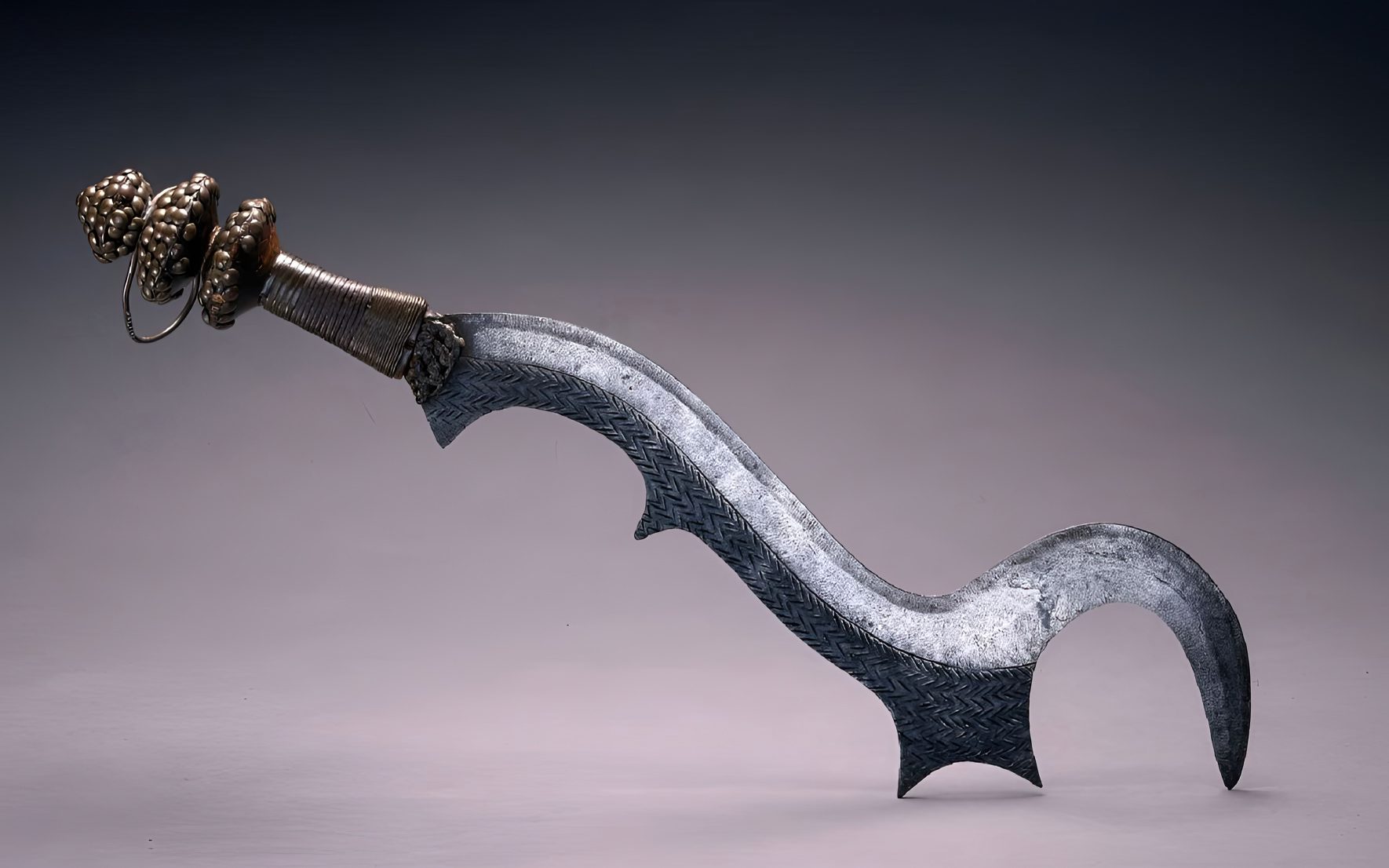
What’s in this article?
Afrifca’s swords are an inspiration for many weapons used in fantasy novels. What the majority of people don’t realize is that some of these swords exist. One such sword that seems unfathomable in our world is the Ngombe Ngulu sword.
The Ngombe Ngulu is one of the most popular swords in Africa due to its unusual and terrifying appearance. This popularity is also due to its dark history reflected in its design.
In this article, we will go over the unique characteristics and details of this weapon and explain how these traits were used. We will also give some background into the sword’s history.
Types of the Ngombe Ngulu Sword

The Ngome Ngulu swords were primarily ceremonial instruments made to impress the crowd with their appearance and be very effective in slashing and chopping motions. That is why there are primarily two types of Ngombe Ngulu swords that vary in their blade edges but still share the same characteristics.
Single Bladed
The most common Ngombe Ngulu sword from history is the single-bladed. This Ngombe Ngulu has only one sickle hook-like blade tip, which is sharpened on the outer edge. This type is mostly ceremonial, with several more blade ridges and points along its edge primarily for aesthetic reasons.
Double Bladed
A rarer blade used in African ceremonies is the double-bladed Ngombe Ngulu, which possesses double sets of curved hook blades that are sharpened on the outer edges. This Ngulu is simpler than the other type, often does not feature any blade ridges along its edge, and has a less complicated handle. Some see this ceremonial type of Ngulu sword as a weapon of higher status.
Characteristics of the Ngombe Ngulu Sword
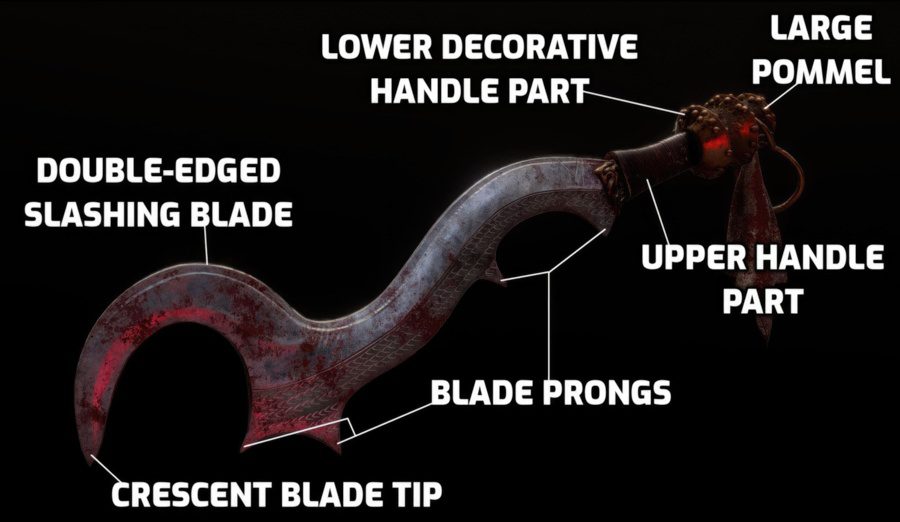
Ngombe Ngulu swords are one of the unique bladed-edged weapons and one of the most terrifying swords in history. Their characteristics are complete with unusual elements that might render them useless for real battle formations. But the Ngombe Ngulu is very effective in ceremonies and executions. The most visual characteristic of the Ngulu is its blade.
Blade

The blade of the Ngombe Ngulu is often made out of iron, but there are cases of steel blades being produced, especially after European Imperialism. Ngulu blades are somewhat straight in the first section and end up in a crescent-like form at the blade tip. Usually, only one crescent can be double or single-edged or a double-bladed tip sharpened on the outer side.
One of the more interesting blade characteristics of the Ngombe Ngulu is the blade prongs. There are usually between two and four, but the reason for their placement is unknown. It may be for aesthetic reasons alone since they aren’t sharpened or as a handle in-between for a stronger grip.
Though the metal blade can resemble a fuller, it is ornamented with African symbols for aesthetic reasons alone. The blade’s crescent tip is also sharpened but mostly used for slashing instead of piercing. A common blade length of the Ngombe Ngulu sword is around 14 to 22 inches (35 to 55 cm).
Guard
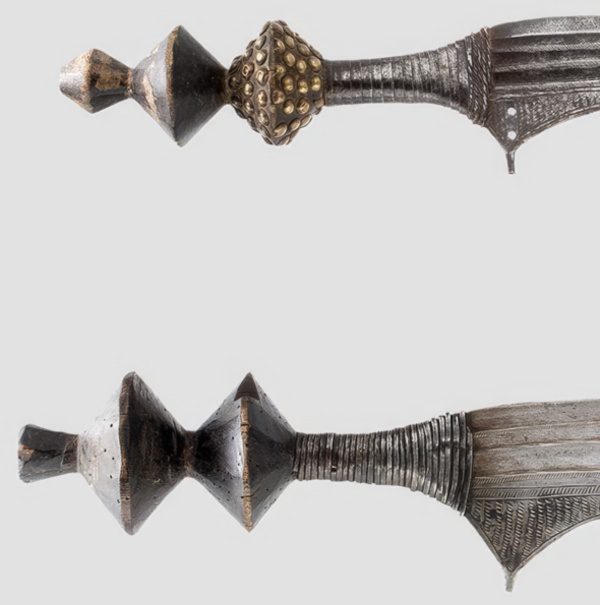
Ngombe Ngulu swords feature no type of guard, likely because the sword is influenced by African throwing knives. Many other African sickle swords were without guards because they were used with a large shield. It’s also possible that the Ngulu lacks a guard because it was a ceremonial sword without the need to protect the user’s hand.
While it is highly disputed, some see the blade prongs, especially the first long one, as a sort of guard that can be used for protection.
Handle

To better understand the handle of the Ngombe Ngulu, it can be split into two parts.
- The upper handle part of the blade tang
- The two large spherical or round buttons at the bottom
The upper part of the handle is where the user’s primary hand goes and is commonly wrapped with copper wire, fiber, leather, or wood. It is straight and broadens at the top, allowing a firm grip. If the Ngulu is double-bladed, this is the only part of the handle.
The second part of the handle is spherical or lens-shaped and made of wood or brass, and they can be decorated with rare metals or nail heads. This part of the handle allows for a two-handed grip on the sword for more powerful and lethal strikes.
Pommel

The pommel is the ending cap of the handle which acts as a counterweight of the Ngulu sword. The pommel is usually simple and made out of wood, but there are cases of it being wrapped with copper or made out of metal. It can also be found in various shapes, such as a pyramid or rounded.
Weight
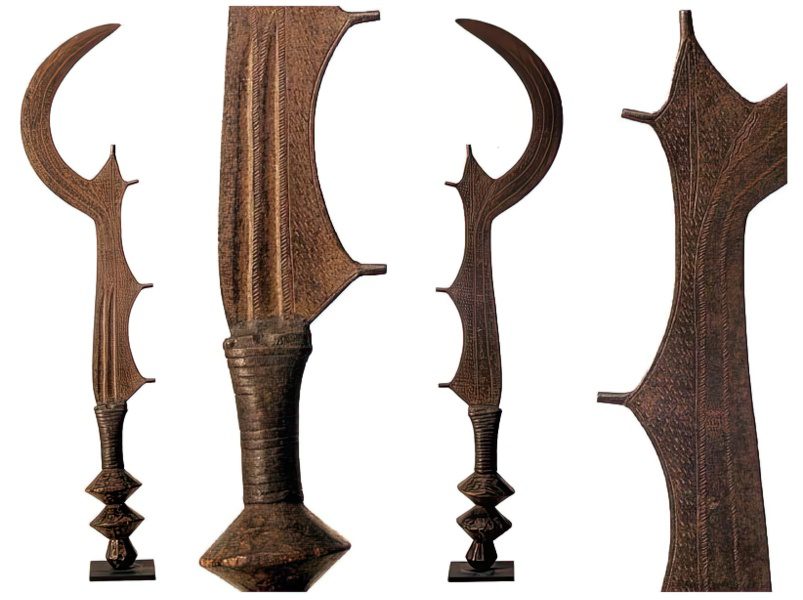
Ngombe Ngulus are relatively substantial because the iron blade needs to be a heavy balance point at the crescent end of the blade for vigorous strikes. A typical weight for the Ngombe Ngulu ranges from 1 to 1.8 lbs (0.45 to 0.8 kg).
Size and Length
While these swords can be used with both hands due to their broader handles, they are not that large. The most usual length for the Ngombe Ngulu executioner swords is between 22 to 31 inches (55 to 80 cm).
Uses for the Ngombe Ngulu Sword
When used with a shield, the Ngombe Ngulu is primarily a one-handed sword if used in a combat-like situation. It would be used primarily for slashing and piercing attacks thanks to its sickle-shaped blade, but it would also be useful for hooking enemy weapons. Still, it is believed that the Ngombe Ngulu was strictly a ceremonial or execution tool used with chopping-like motions.
Ceremonial and Prestigious
Exotic African swords with many decorative elements may not be effective in battle and were instead very good “dress swords” linked with the nobility of chiefs and dignitaries. The Ngombe Ngulu shined in this respect because it was part of a cultural tradition and a sword used for human sacrifice.
Sacrifice and Execution
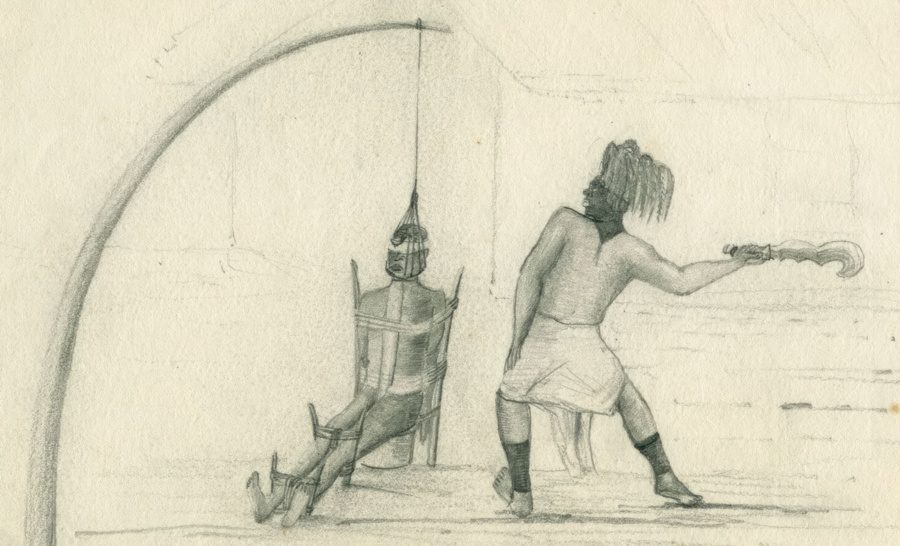
The primary reason the Ngombe Ngulu is known as Africa’s executioner sword is the high number of executions and sacrifices it was used for. These executions were not traditionally inflicted on criminals after a judicial event. Instead, they were religious and ceremonial events done on newly acquired and chosen slaves. This often occurred after the death of a tribal chief, as a peace offering between two warrant tribes, ceremonial cannibalism, or sometimes for profit.
Trade Currency
Iron and metal were valued throughout the regions where the Ngombe Ngulu was used. Swords like the Ngulu were highly sought after in trade networks and would sell for a large profit. It could also be given as a gift binding tribal groups together or as a wedding dowry. It was also used by traditional African religious groups not affected by Christianity or Islam prior to the 20th century.
History of the Ngombe Ngulu Sword
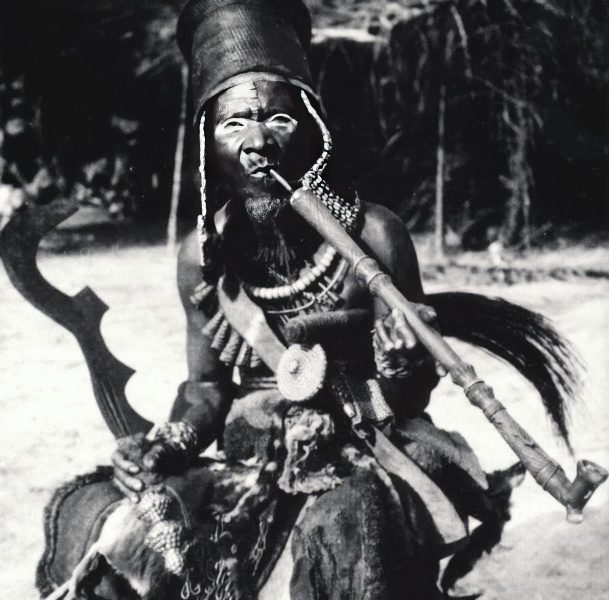
The Ngombe Ngulu is an African sickle sword mainly used around Central Africa’s regions in the modern-day Democratic Republic of Congo. It is attributed to the Mongo and Bangala regions, language and people, and the Ngombe Tribe.
Some trace the origins of the Ngombe Ngulu to the predecessor of all sickle swords in Africa, the Egyptian Khopesh. Although this may be true, the sickle-shaped form seen in Central, East, and Northeastern African swords is likely a result of prestigious throwing knives with sickle-shaped boomerang forms that were effective in hunting, agriculture, and warfare. These could have reached Congo by the trade routes along the rivers.
“The victim was sitting on a piece of wood with his or her legs stretched out in front of them. Several wooden stakes were driven into the ground around the victim so that ropes could be tied to the arms, legs, knees, and feet. A bendable tree branch was used as a fishing pole to tie the victim. A rope was put around the victim’s neck, and the tensioned tree branch was now pulling on the victim’s head all the time without actually suffocating them. The head was then cut off from the body with one blow from the Ngulu sword. The tight branch threw the head into the air, and people in the crowd tried to grab the trophy or prize.” – Edward James Glave, late 20th century
The exact origins of the Ngombe Ngulu are unclear, as with many other African swords, but the earliest depictions are in the late 19th and 20th centuries by European travelers. These travelers describe the sword as an execution instrument linked with many “savage” elements.

These historical pieces of information might be heavily exaggerated in some cases. Still, in the regions around modern-day Congo, known previously as Zaire or Ngala, human executions by swords, along with cannibalism, were practiced by some of the tribes.
Swords like the Ngombe Ngulu, human sacrifice, and beheadings were banned in Belgium, which controlled several territories during the colonial era at the end of the 20th century. The ritual of Ngulu beheading was then performed on goats and moved onto African traditional sword dances known as Likbet. The sword became mainly ceremonial and was no longer used for executions.




